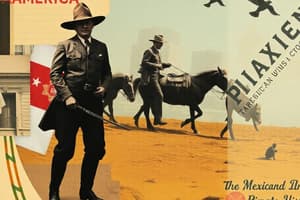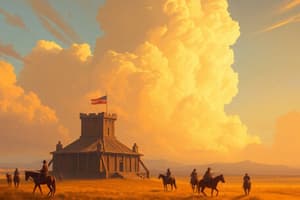Podcast
Questions and Answers
Which of these best describes the primary focus of the standards related to westward expansion?
Which of these best describes the primary focus of the standards related to westward expansion?
- Studying the lives of indigenous people before colonization.
- Learning about the expansion of the United States to the west. (correct)
- Analyzing modern trade policies in the United States.
- Understanding the geography of European countries.
A student learning about westward expansion would most likely NOT focus on which geographical study?
A student learning about westward expansion would most likely NOT focus on which geographical study?
- Detailed maps of ancient Roman cities. (correct)
- Locations of important settlements during the expansion.
- Rivers and trails used by settlers.
- Mountains and other physical barriers.
How might the concept of 'opportunity cost' apply to westward expansion?
How might the concept of 'opportunity cost' apply to westward expansion?
- The low cost of land in the East.
- The low price of trading manufactured goods.
- The benefits of remaining in established cities rather than moving West. (correct)
- The amount of gold found in California after the gold rush.
Which of these best exemplifies 'specialization' during westward expansion?
Which of these best exemplifies 'specialization' during westward expansion?
In what way did 'voluntary exchange' play a role during westward expansion?
In what way did 'voluntary exchange' play a role during westward expansion?
What would most likely increase 'productivity' related to westward expansion?
What would most likely increase 'productivity' related to westward expansion?
How did 'price incentives' impact westward expansion?
How did 'price incentives' impact westward expansion?
A map showing westward expansion would most likely include which of the following?
A map showing westward expansion would most likely include which of the following?
What is the essential skill emphasized by having students locate 'man-made' features related to westward expansion on a map?
What is the essential skill emphasized by having students locate 'man-made' features related to westward expansion on a map?
Which skill is NOT a focus for a student studying westward expansion?
Which skill is NOT a focus for a student studying westward expansion?
Which of these is considered a physical feature acting as a barrier or gateway?
Which of these is considered a physical feature acting as a barrier or gateway?
What was a primary outcome of the War of 1812?
What was a primary outcome of the War of 1812?
How did the United States significantly expand its territory during the 19th century?
How did the United States significantly expand its territory during the 19th century?
What impact did westward expansion have on American Indians?
What impact did westward expansion have on American Indians?
Which of the following was a major technological advancement during the period detailed?
Which of the following was a major technological advancement during the period detailed?
What technological development significantly impacted the processing of cotton?
What technological development significantly impacted the processing of cotton?
What is meant by 'opportunity cost' in an economic context?
What is meant by 'opportunity cost' in an economic context?
How do price incentives typically affect market behavior?
How do price incentives typically affect market behavior?
What is the economic concept of 'specialization'?
What is the economic concept of 'specialization'?
What is a key characteristic of a 'voluntary exchange'?
What is a key characteristic of a 'voluntary exchange'?
Why is trade essential in economic development?
Why is trade essential in economic development?
Which innovation significantly increased the speed and efficiency of water travel?
Which innovation significantly increased the speed and efficiency of water travel?
What effect did the steam locomotive have on the United States?
What effect did the steam locomotive have on the United States?
What was an immediate effect of the introduction of the cotton gin?
What was an immediate effect of the introduction of the cotton gin?
Based on all this information, what can be inferred about how technology impacted the United States in this period?
Based on all this information, what can be inferred about how technology impacted the United States in this period?
Flashcards
Westward Expansion
Westward Expansion
Moving westward in a quest for new land, resources, and opportunities. This involved settling new areas and expanding the United States' borders.
Economic Opportunity
Economic Opportunity
The driving force behind westward expansion. It was the idea of using the land and resources available for economic advantage and profit.
Specialization
Specialization
A major economic concept describing the increasing skill and efficiency in producing goods or services, often leading to higher productivity and lower costs.
Voluntary Exchange
Voluntary Exchange
Signup and view all the flashcards
Price
Price
Signup and view all the flashcards
Price Incentives
Price Incentives
Signup and view all the flashcards
Productivity
Productivity
Signup and view all the flashcards
Cost
Cost
Signup and view all the flashcards
Westward Migration
Westward Migration
Signup and view all the flashcards
Migration
Migration
Signup and view all the flashcards
Physical Barriers and Gateways
Physical Barriers and Gateways
Signup and view all the flashcards
What caused the War of 1812?
What caused the War of 1812?
Signup and view all the flashcards
Key events in US territorial expansion
Key events in US territorial expansion
Signup and view all the flashcards
Impact of Westward Expansion on Native Americans
Impact of Westward Expansion on Native Americans
Signup and view all the flashcards
Impact of the steam engine on transportation
Impact of the steam engine on transportation
Signup and view all the flashcards
The impact of the Telegraph
The impact of the Telegraph
Signup and view all the flashcards
How did the cotton gin impact agriculture?
How did the cotton gin impact agriculture?
Signup and view all the flashcards
What are economic indicators?
What are economic indicators?
Signup and view all the flashcards
Define opportunity cost
Define opportunity cost
Signup and view all the flashcards
What are price incentives?
What are price incentives?
Signup and view all the flashcards
What is specialization in economics?
What is specialization in economics?
Signup and view all the flashcards
What is voluntary exchange?
What is voluntary exchange?
Signup and view all the flashcards
What is trade in economics?
What is trade in economics?
Signup and view all the flashcards
Study Notes
Westward Expansion
- Westward expansion in America involved various causes and events, including the War of 1812, the burning of the Capitol and White House, and the writing of "The Star Spangled Banner".
- The impact of westward expansion on American Indians involved actions like the Trail of Tears, the Battle of Little Bighorn, and forced relocation to reservations. Primary and secondary sources are crucial to understand these events
- Territorial expansions, such as the Louisiana Purchase, the Lewis and Clark expedition, and acquisitions of Texas, Oregon, and California (Gold Rush), are key elements of the period. Learning about these events requires understanding primary and secondary sources to draw conclusions.
- Important physical features relate to westward expansion, including the Atlantic Coastal Plain, Great Plains, Continental Divide, Gulf of Mexico, Mississippi River, and the Great Lakes.
- Man-made features, including Washington, D.C., and the Erie Canal, are also essential to understanding the expansion.
- Physical barriers like terrain hindered westward expansion but physical gateways, such as waterways, allowed for easier passage.
- Opportunity cost and decision-making, across time, are related to settling in the West.
- Understanding issues and/or problems and alternative solutions are important
- How price incentives affect people's behavior and choices, such as cotton and tobacco production, are key factors
- The impact of westward expansion on different economies, like the North and South, are included.
- Technological advancements, like the cotton gin, steamboat, steam locomotive, and telegraph, had a significant impact on productivity.
- Economic concepts, like trade, opportunity cost, specialization, voluntary exchange, productivity, and price incentives, played key roles
- Factors such as trade between the U.S. and Europe, or the U.S. and Canada impacted the expansion
- Understanding the war of 1812 is important in understanding the causes and events of westward expansion
- The Louisiana Purchase significantly expanded the size of the United States, granting control of the mouth of the Mississippi River.
- The Lewis and Clark Expedition explored new territory. The purpose of this expedition included charting a water route to the Pacific Ocean, and documenting new plants, animals, the climate, and the people.
- The process of acquiring Texas involved the American settlers and the Mexican government and ultimately, Texas declared independence from Mexico
- The creation of the Oregon Trail facilitated access to the Oregon Territory. The difficulties of crossing the Continental Divide were a major factor.
- The California Gold Rush in 1849 drew thousands westward to find riches, creating boomtowns and settlements.
- Trail of Tears involved the forced relocation of American Indians in the Southeast to reservations in what is now Oklahoma. This forced removal was disputed in the courts
- The Battle of Little Bighorn involved conflict between the U.S. Army and Native Americans over forced relocation to reservations.
American Indian Experience
- Many American Indians died from diseases carried by settlers
- Decrease in the buffalo population impacted Indian survival.
- Some religious practices were declared illegal by the U.S. government.
- Children could not speak their native languages or wear their traditional clothing at reservation schools
- The impact of the forced removal of American Indians is a major factor in understanding the time period
- The Trail of Tears, a forced relocation, is crucial, marked by the Cherokee travel.
New Technologies
- Steamboat, locomotive, and telegraph advanced trade, communication, and travel, opening up new frontiers, and establishing faster ways to move goods and people.
Economic Indicators
- Pioneers facing opportunity cost decisions
- Price and incentive effects
- Cotton and the cotton gin
Studying That Suits You
Use AI to generate personalized quizzes and flashcards to suit your learning preferences.




